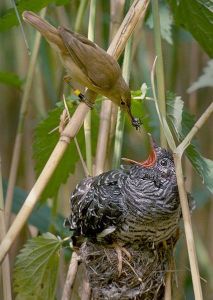Baby Birds Bump Off Competition
Aww, look at the little birdie feeding the big birdie:
That’s a mama reed warbler and a baby cuckoo (note that the cuckoo doesn’t fit in the nest). It’s an adorably awkward scene—until you realize how it came about.
European Cuckoos are brood parasites, a.k.a. mooches, who pawn all of their chick-rearing duties off on birds of other species. Female cuckoos lay their eggs in other birds’ nests and the other bird (the host parent) incubates the cuckoo egg alongside their own. When the cuckoo chick hatches, it identifies any solid objects in the nest (eggs or hatchlings) and, using the shovel-shaped dent in its back, shoves its foster siblings out of the nest. The host’s eggs fall to their death and the host mother, left with nothing but a big-ass cuckoo in her nest, raises it as her own.
And they all live happily ever after (except for the chicks that don’t, of course).
Scientists estimate that one-percent of all bird species practices brood parasitism. The strategy enables the mother to devote more time to eating, mating and making more babies (measures of success in ecology) rather than wasting energy building a nest, incubating eggs and feeding and defending her chicks. For the whole plan to work, however, her chicks need to survive and to do that, they’ll need to outcompete their foster siblings. That’s all European cuckoo chicks are doing when they shove the host eggs out of the nest. Sure, they could be nicer about it (cowbird chicks manage to snag more food from their foster parents by simply growing faster than their foster siblings), but they could also be a whole lot nastier.
Meet the African greater honeyguide (Indicator indicator). As an adult, the honeyguide is an “indicator”, that guides people to bee hives. As a chick, it’s a little f**ker, that brutally murders its foster siblings.
Female African greater honeyguides lay their eggs in the underground nests of little bee-eater birds (who make their nests in abandoned aardvark burrows). The honeyguide mama does her best to ensure that her little bundle of joy will thrive with its host parents. She internally incubates each egg for an extra day to make sure that it will hatch before its foster siblings and, when she dumps her egg off in the little bee-eaters’ nest, she punctures all the little bee-eater eggs she can find. The punctured eggs don’t survive, but some eggs avoid puncturing (or are laid after the delivery of the honeyguide egg) and hatch a couple of days after the honeyguide chick. That’s when things turn ugly.
Within an hour of hatching, the little bee-eater chick is attacked by a blind, featherless monster with spear-like hooks on its beak. This monster (the three-gram honeyguide chick) pokes, grabs and shakes its foster sibling for an average of 177 seconds. After a vicious (and apparently exhausting) attack, the little bee-eater chick stops moving and the honeyguide chick stops attacking. The little bee-eater chick dies from internal hemorrhaging and bruising sustained in the attack anywhere from nine minutes to seven hours later.
The little bee-eater parents, who were present during the attack but apparently completely clueless about the murder*, continue to feed and nurture the little s**t as their very own. About a month later, the honeyguide emerges from the nest. Its billhook has grown out into a completely normal, innocent-looking bill.
*In their defense, it is completely dark in their underground nest.
Warning: The following video is very disturbing:
********
In other siblicidal news, I wrote about sandtiger sharks and other baby animals that kill their blood siblings a few years ago. (Here’s the post.) Just last week, Kevin Zelnio (of Deep Sea News fame) found a video of sandtiger shark siblicide. It is horrifically awesome. Check it out here.
Spottiswoode, C., & Koorevaar, J. (2011). A stab in the dark: chick killing by brood parasitic honeyguides Biology Letters DOI: 10.1098/rsbl.2011.0739







That video is definitely a bit disturbing – cool but disturbing.